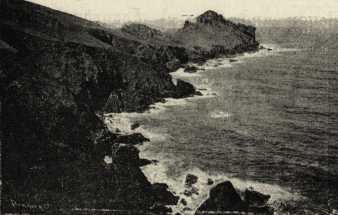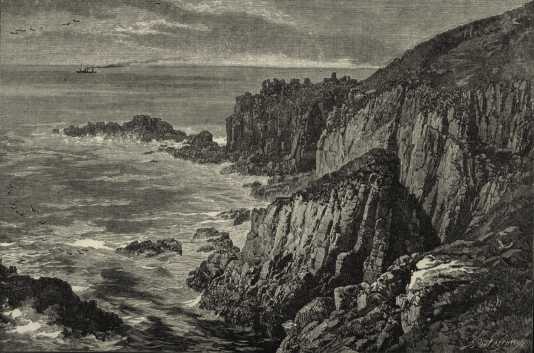| First Page | Previous Page | Next Page |

WHEN St. Ives first became a resort for Artists is not known. Probably the Phœnicians, who seem to have been at the bottom of everything in Cornwall, founded an art colony here, and took back with them, with the tin and copper, impressionist sketches of St. Ives Bay and the surrounding country. Suffice it to say, in the way of ancient history, that so long has St. Ives been visited by painters in pursuit of their art., that, to use the old law phrase, “the mind of man runneth not to the contrary.[”] It is of St. Ives as the abode of a continuously residential colony of artists that we would speak, and for that we most go back rather more than ten years.
St. Ives had before then been visited summer after summer by painters of greater or less note, who hailed from London and elsewhere, and who used St. Ives as a temporary sketching ground. The fishermen “down along” have still stories to tell of “Squire” Hook (the Royal Academician, whose seascapes still delight us), of the late Mr. Henry Moore, R. A. (who, alas! painted the last of his blue rolling seas last year), of Mr. Whistler, and many others. Amongst those whose names are well remembered as old frequenters are Mr. R. W. Allan, A.R.W.S. Mr. W. H. Bartlett, the late Mr. Vernier, a well-known French artist of great talent ; Mr. and Mrs. Chadwick (the latter afterwards prominent members of our settled colony, and respectively forerunners of many American and Scandinavian artists, who have chosen St. Ives for a lengthy sojourn). It is to the year 1885 that most be perhaps ascribed the first settlement of St. Ives as an all the year round place of abode and work for artists. Newlyn, on the south coast of Cornwall, had for some years been so settled; but, as we have said, St. Ives had theretofore been only a Place of sojourn to nomadic painters. The year before a small studio (which has long since gone back to its original state of ruin) had been constructed by the Hon. Duff Tollemach out of a disused and ruinous building at Carn Crowse, and in 1885 Mr. and Mrs. Harewood Robinson and Mr. William Eadie had studios made (in the one case out of an old wooden carpenter’s shop, in the other out of an out-house), and settled in St. Ives as winter residents. The following summer a number of painters swooped down on St. Ives with the intention of making it their abode and field of labour. Mr. and Mrs. E. E. Simmons, Mr. Louis Grier (followed by his brother, Mr. E. Wyly Grier), Mr. Howard Russell Butler, Mr. and Mrs. Chadwick, and afterwards, in quick succession, Mr. and Mrs. Adrian Stokes, Mr. and Mrs. Grönvold, Mr. Julius Olsson, Mr. Lowell Dyer, Mr. Zorn (whose picture of St. Ives in the Luxembourg Gallery has contributed no little to the popularity of St. Ives), Miss Scherfbeck, Mr. Blomefield, and Mr. W. H. Y. Titcomb.
Old sail lofts and cottages were sought out, and turned into studios, and large skylights appeared everywhere among the grey roofs of the old town; by the enterprise of the townsp[e]ople new studios were built, some of imposing size, and St. Ives took its place as a world-known centre of art work.
For these ten years St. Ives has had and kept a truly cosmopolitan character — painters have resorted to it from all countries, from the United States, Canada, Australia, France, Germany, Austria, Holland, Danemark, Norway, Sweden, and farthest Finland; and pictures painted have carried something of St. Ives into all countries. In all the chief exhibitions of Europe, in our Royal Academy, and Municipal Exhibitions; in the salons of Paris, Berlin, and Munich; in the galleries of America; in Canada, Australia, and New Zealand; in short, everywhere where pictures are to be seen some work is to be found which owes its inspiration to our little Cornish fishing town. Pictures painted in St. Ives have been acquired by the Chantry Fund for the Nation, by the French Government for the Luxembourg, by the chief English Corporations for Municipal Collections, and by Art Societies for the public galleries of America.
In the year 1887 a small gallery for the exhibition of works by members of the community was, at the instance of the artists, opened by Mr. Lanham. It has since been enlarged and improved. Pictures are selected and hung by a Committee of Artists chosen by the Exhibitors from amongst themselves.
In the year 1888 an Artist’s Club was formed by Mr. Louis Grier, and met for a year in his studio. In 1890 a permanent club was established, and has a yearly membership list of from seventy to eighty.
It is manifestly impossible to give a list of the artists who have made St. Ives their home. Amongst the many past and present members of the community, or periodically visiting St. Ives, may be mentioned, in addition to those already spoken of, Messrs. Ernest Waterlow, A.R.A., Herbert Marshall, Alfred East, Barlow, Folliot Stokes, Millie Dow, Jameson, Laurence Eastlake, Arnesby Brown, Morris, Talmage, Fuller, Bosch Reitz, Jevons, and Ludby.
BEYOND the immediate environments of the town the district is extremely interesting and beautiful, whilst each part bears a distinctive charm in fact, the charming character of the surrounding country cannot be justly described by the most descriptive pen, and we will, therefore, content ourselves with merely pointing out those places which are really worthy of the tourist’s special attention. Leaving the town by the New Road, the first point approached is Tregenna Castle Hotel, which stands in its own grounds, and, taken generally, has more the appearance of a gentleman’s country seat than a licensed estab[l]ishment. In fact it is only of late years it has served the present purpose having previously been the residence of the Stephens family since which it has changed hands twice, ultimately becoming the property of the Great Western Railway Company. Since its establishment the hotel has been largely and influentially patronised, and the panoramic scenery to be obtained from the hotel grounds cannot be equalled in the county. Immediately behind the hotel grounds stands the far famed pyramid, familiarly known as Knill’s Monument, of which so much has been written in other local publications that we do not consider it necessary to describe the Knillian ceremonies. This quaintly interesting celebration takes place in the month of July of this year. About a couple of miles beyond is Trencrom Hill, 550 feet above the sea level. This wild spot was once crowned with a British fortress, the only remains of which are a ditch and a wall with a gate. Not long since there was an ancient granite cross, but this has disappeared. Many legends are associated with this solitary place, and to visit it is to believe that it was once the recreation ground of giants, whose favourite amusement was playing at “bob-button” with the giant of St. Michael’s Mount, the buttons consisting of the huge granite boulders so common on the hill-top. From the summit of Trencrom the views of the adjoining country are unparalleled for their extensive character.
Travelling west from St. Ives, via Carthew and Clodgy, the visitor’s eye will become ravished with delightful visions of wild and rugged headlands jutting out into the sea, and constituting some of the most characteristic scenery on the western coast. Passing through the interesting village of Zennor the Gurnard’s Head is reached. This is a bold promontory, consisting of huge masses of rocks, remarkable for their singularly romantic and craggy appearance. The Head was once fortified, and the remains of a chapel are to be seen, the granite altar-stone being still intact.

GURNARD’S HEAD.
CARBIS BAY is the most beautiful suburb of St. Ives, about one mile distant, and is approached by a picturesque cliff-path which commands unique views of coast scenery, extending from the Hayle Bar to Trevose Head, the lighthouse-covered promontory near Padstow. Godrevy Lighthouse, within the “Cow and Calf” beyond, are points of interest to be observed from this view, but along the coast may be seen a dark fringe of sea-weed-covered rocks running out to little points and enclosing tiny coves bright with golden sands and pebbles. Carbis Bay has always been deservedly popular, but the erection of the beautiful “Carbis Bay” Hotel has done a great deal to make the district known to visitors from all parts. The building is of commodious dimensions and splendidly designed from the plans of Mr. Silvanus Trevail. A visitor to the hotel described the outlook in the following graphic language:— “From the hotel windows visitors look out on the open sea, from which there comes to them the constant roar of the ocean’s ceaseless roll, as it leaves one of the finest beaches of North Cornwall coast. Everything in the hotel is eloquent of comfort and entire rest.” It overlooks a wide expanse of blue sea, lapping miles of firm sandy beaches. Seen on a bright day, under a sunny blue sky, this view cannot but prompt a spontaneous outburst of admiration. A little beyond Carbis Bay the West Cornwall Golf Club are situated. These are now recognised as the best links in the West of England, surpassing those of the Westward Ho.
THESE Links consist of 113 acres of towans, stretching from Hawke’s Point nearly to Lelant Station, and are leased by Mr. Tyringham to the trustees for the use of the above Club. They consist of 18 holes, extending about two miles and three-quarters; and a second course of 9 holes, 1,400 yards round, for the ladies. There are no more sporting links in England than these, and the greens are kept in perfect order.
They are easily reached from St. Ives, and visitors are allowed to play on introduction by a member. The fees for visitors are 5/- a week or 15/- a month.
Candidates for membership have to be proposed and seconded by members, and the election is by the committee. The entrance fee is £3 3s; annual subscription £1 1s.

LAND’S END
| First Page | Previous Page | Next Page |